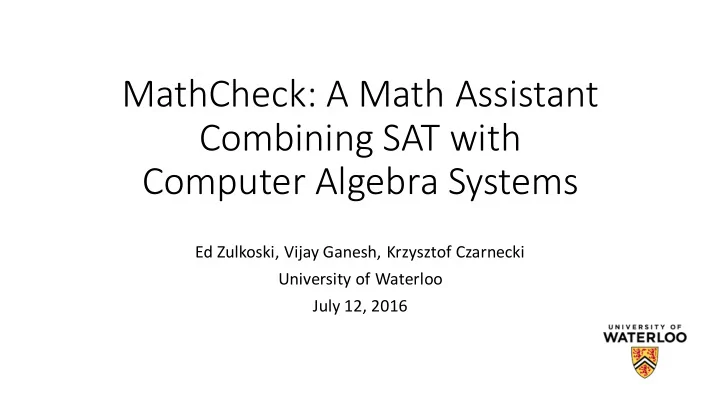

MathCheck: A Math Assistant Combining SAT with Computer Algebra Systems Ed Zulkoski, Vijay Ganesh, Krzysztof Czarnecki University of Waterloo July 12, 2016
Problem Statement Many problems have an underlying Boolean structure, but are not easi sily expresse ssed d using standard SAT/SMT solvers. Acyclicity (Gebser’14) Constrained Clustering (Métivier’12) Hamiltonicity (Velev’09) Finite domain search + complex x predicates. 2
Goals • Computer algebra systems (CAS) contain SOTA algorithms for solving complex properties • SAT solvers are one of the best general approaches for finite domain search • Goal 1 : incorporate algorithms from a CAS with a SAT solver for: • Counterexample Construction for Math Conjectures • Bug finding • Goal 2 : design an easily extensible language/API for such a system • Current focus is on graph theory 3
DPLL(CAS) Architecture Extensibility preferred to a “one -algorithm-fits- all” approach. 4
Graph Variable Representation graph x(6) • One Boolean per each potential vertex • One Boolean per each potential edge • Mapping between graph components and Booleans to facilitate defining SAT-based graph constraints 5
Case Study: Ruskey-Savage Conjecture Conjecture: For every 𝑒 ≥ 2 , any matching of the hypercube 𝑅 𝑒 extends to a Hamiltonian cycle. • Matching – independent set of edges that share no vertices • Maximal – cannot add edges without violating the matching property • Perfect – it covers all vertices • Hamiltonian cycle – cycle that touches every vertex • Previously shown true for 𝑒 ≤ 4 𝑅 3 6
Case Study Specification ( ) graph x(32) sage.CubeGraph G(5) // ∀𝑦. 𝑛𝑏𝑢𝑑ℎ𝑗𝑜 𝑦, 𝐻 ⇒ 𝑓𝑦𝑢𝑓𝑜𝑒𝑡_𝑢𝑝_ℎ𝑏𝑛𝑗𝑚𝑢𝑝𝑜𝑗𝑏𝑜(𝑦, 𝐻) assert( matching(x,G) ∧ imperfect_matching(x,G) ∧ maximal_matching(x,G) ), query( extends_to_Hamiltonian_cycle(x,G)) Unsat 7
Case Study Specification ( ) graph x(32) sage.CubeGraph G(5) // ∀𝑦. 𝑛𝑏𝑢𝑑ℎ𝑗𝑜 𝑦, 𝐻 ⇒ 𝑓𝑦𝑢𝑓𝑜𝑒𝑡_𝑢𝑝_ℎ𝑏𝑛𝑗𝑚𝑢𝑝𝑜𝑗𝑏𝑜(𝑦, 𝐻) assert( matching(x,G) ∧ matching(x,G) Blasted to SAT imperfect_matching(x,G) ∧ maximal_matching(x,G) ), query( extends_to_Hamiltonian_cycle(x,G)) Unsat 8
Case Study Specification ( ) graph x(32) sage.CubeGraph G(5) // ∀𝑦. 𝑛𝑏𝑢𝑑ℎ𝑗𝑜 𝑦, 𝐻 ⇒ 𝑓𝑦𝑢𝑓𝑜𝑒𝑡_𝑢𝑝_ℎ𝑏𝑛𝑗𝑚𝑢𝑝𝑜𝑗𝑏𝑜(𝑦, 𝐻) assert( matching(x,G) ∧ Blasted to SAT imperfect_matching(x,G) ∧ imperfect_matching(x,G) maximal_matching(x,G) ), query( extends_to_Hamiltonian_cycle(x,G)) Unsat 9
Case Study Specification ( ) graph x(32) sage.CubeGraph G(5) // ∀𝑦. 𝑛𝑏𝑢𝑑ℎ𝑗𝑜 𝑦, 𝐻 ⇒ 𝑓𝑦𝑢𝑓𝑜𝑒𝑡_𝑢𝑝_ℎ𝑏𝑛𝑗𝑚𝑢𝑝𝑜𝑗𝑏𝑜(𝑦, 𝐻) assert( matching(x,G) ∧ Blasted to SAT imperfect_matching(x,G) ∧ maximal_matching(x,G) ), maximal_matching(x,G) query( extends_to_Hamiltonian_cycle(x,G)) Unsat 10
Case Study Specification ( ) graph x(32) sage.CubeGraph G(5) // ∀𝑦. 𝑛𝑏𝑢𝑑ℎ𝑗𝑜 𝑦, 𝐻 ⇒ 𝑓𝑦𝑢𝑓𝑜𝑒𝑡_𝑢𝑝_ℎ𝑏𝑛𝑗𝑚𝑢𝑝𝑜𝑗𝑏𝑜(𝑦, 𝐻) assert( matching(x,G) ∧ Blasted to SAT imperfect_matching(x,G) ∧ maximal_matching(x,G) ), Checked with SAGE query( extends_to_Hamiltonian_cycle(x,G)) extends_to_Hamiltonian_cycle(x,G) Unsat 11
Case Study Specification ( ) graph x(32) sage.CubeGraph G(5) // ∀𝑦. 𝑛𝑏𝑢𝑑ℎ𝑗𝑜 𝑦, 𝐻 ⇒ 𝑓𝑦𝑢𝑓𝑜𝑒𝑡_𝑢𝑝_ℎ𝑏𝑛𝑗𝑚𝑢𝑝𝑜𝑗𝑏𝑜(𝑦, 𝐻) ~10 LOC assert( matching(x,G) ∧ Blasted to SAT ~5 LOC imperfect_matching(x,G) ∧ ~5 LOC maximal_matching(x,G) ), ~25 LOC Checked with SAGE query( extends_to_Hamiltonian_cycle(x,G)) extends_to_Hamiltonian_cycle(x,G) Unsat 12
2 2 13 1 2 1 2 2 2 2 2 1 8
Case Study Approach • Unsat after ~8 hours on laptop (Conjecture holds for 𝒆 = 𝟔 ) • For a pure SAT encoding, we need encode non-trivial Hamiltonicity constraints 14
A Sage- only approach… • Without SAT, we need a problem-specific search routine #Checks of extends_to_Hamiltonian_cycle Matchings 13,803,794,944 Imperfect Matchings 4,619,529,024 Maximal Imperfect Matchings 6,911,604 SAT Approach 384,000 • A Sage-only approach is: • Potentially less efficient • Potentially more error-prone 15
Recommend
More recommend